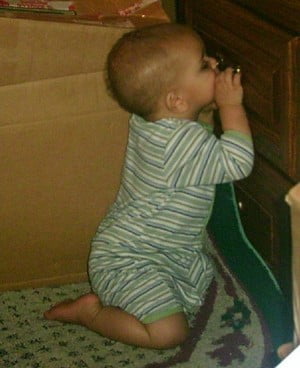Being a parent of a newborn can be a wondrous thing, but if you are a first time parent, there are also a lot of unknowns. You may not know when your child is “supposed” to reach certain milestones during the stages of infant development. While not all infants do things at the exact same age, there is a timeline that most infants follow in their development. As a mother of three sons, I have been through all of the developments. Some have been on schedule and some have been behind. This article will go through the common stages of infant development up to the first year.
Stage One: 1 – 3 Months
The first month of your child’s life probably goes by in a blur because you’re dealing with a newborn. You have the thrill of new parenthood. It’s also when you realize how little sleep you are getting. While you are dealing with that, your infant’s neck muscles are beginning to develop, so your baby will be able to lift his or her head on his own when he is around 2 months old.
In addition to being able to lift his or her head on his own, 2 months also brings the ability to smile, and I mean a real smile, not one that might just be from gas. Your infant will also will start cooing, which in turn makes you smile. When my children developed new abilities, it made my whole face and heart light up.
Three months brings a new noise from your infant – squealing – as well as the new-found joy of sucking on his or her own hands. My kids always loved to suck on their hands; it was like they viewed it as a new toy that was attached to them.
Stage Two: 4 – 6 Months
At 4 months, infants start the dreaded “putting things in their mouth” phase. This is when you have to be on an even higher alert, because they will put anything that they can grab into their mouth, including things they really shouldn’t. Your infant may also be able to roll over and recognize his or her name when you say it. Plus, 4 months can be when your child starts teething, though most babies still start teething when they are a little older. Around this time frame is when your infant may be ready for solid food such as baby cereal.
Sitting on their own for short bouts is something parents may see when infants are in their fifth month. Be sure you have the camera ready, because it certainly is a picture-worthy moment.
Six months is when infants can get into a crawl position and rock back and forth. It’s both cute and a little funny, because they really can’t move past doing that, so your child may be in that position for a few minutes before laying back down again.
Between 4 and 6 months, your child will start to get the grasp of cause and effect. It’s when your child will drop something, and you’ll pick it back up and give it back. Then your infant starts to realize that if he or she drops something, you’ll give it back, so your baby will try to do it again and again and again until you’ve had enough. Your infant will also start to recognize objects and form an attachment to you (something I’m sure you’ve been waiting for). That means if you leave the room, your baby may start crying because he or she knows you are gone.
Stage Three: 7 – 9 Months
Seven to 9 months is where some fun stages of infant development start happening. Your child will start bouncing in place. Get a bouncer; it’s a lot of fun to watch your child in it. Also around this time, infants can hold their own bottle, which will give you a bit of a break, though it may also be a little heart-wrenching.
At this point infants will also be able to understand your tones, so when you’re angry or happy, they will know it and act accordingly. Your infant will also reach the beginning to crawl stage, and, as he or she gets older, your baby may be able to stand up when holding onto something like a table.
At 9 months, infants grow even more. Your baby may understand a simple question such as, “Do you want juice?” Don’t be surprised if your child can even speak by saying short words (though one of my children didn’t speak until much later, so don’t be alarmed if your baby doesn’t say an actual word). Your child also learns the ability to walk, as long as he or she has something to hold onto, such as the length of the couch.
Stage Four: 10 – 12 Months
Ten to 12 months is typically when a child learns to walk on his or her own. I remember the excitement of those days when your child takes a few steps, falls down and then gets back up and walks again. For me, that was when I realized that my child was really growing up right before my eyes.
Your child may also start to babble and make up sentences that seem to make no sense whatsoever. It is great fun to listen to babies talk at this stage, because it is a sign that they’re growing up, and it’ll be no time at all before they actually make sense when they talk.
Eating and drinking independently is another stage of development in this age range. Babies will develop the ability to hold onto simple utensils and the handle of a cup.
If your child hasn’t reached some of the stage developments that other infants commonly have at that age, don’t worry. Give it a little time, and if it truly seems like a problem, then take your child to the doctor to see if there is something wrong. Not all of my children met all of the stages of development at these times, and they turned out okay. Some kids just need a little extra time.
Sources:
New Baby Development: First Year Growth,” Surebaby.com.
Wikimedia: http://en.wikipedia.org/wiki/Child_development_stages


